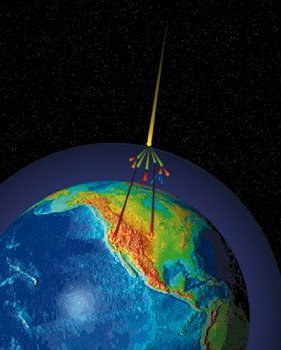Muons are elementary particles similar to electrons. They were discovered in 1936 by Carl Anderson and Seth Neddermeyer at Caltech in 1936. They have a negative charge and are two hundred times as heavy as an electron. They occur naturally as a result of cosmic rays hitting the atmosphere of the Earth. About ten thousand muons hit every square meter of the Earth’s surface every minute of every day. They decay in about two millions of a second into an electron and some neutrinos.
Muons do not interact as much with ordinary matter as electrons and are not influenced as much as electrons by magnetic fields. They tend to pass through ordinary matter and penetrate deep into the earth. Muon detectors have been placed between one of the great pyramids in Egypt to detect hidden chambers. The muon images look a lot like x-rays and will show the shadows that map out different densities of matter and cavities.
Muons are strongly affected by passing through uranium and plutonium because they are so dense. Scientists have speculated that muons might be useful in detecting these elements in buried repositories. The problem is that the shadow muon “x-ray” is two dimensional and not very good for identifying the exact position of things.
Recently, scientists led by Guy Jonkmans at Atomic Energy of Canada in their Chalk River Laboratories nuclear lab in Ontario, Canada, have announced a method for generating a three dimension image from a muon scan. By placing muon detectors above and below repositories, the trajectory of muons passing through the repository can be tracked. With this information, computer image processing can build up a three dimensional image.
This muon scanning technique could be very useful in identifying the presence and location of uranium and plutonium in buried waste repositories. Jonkmans and associates have tested their new technique and verified that it works. Now they have to work on creating a practical system that can be deployed to the field. Working with buried radioactive materials will make such work difficult and dangerous.
There are buried nuclear waste materials at various sites which are not well documented. It is not know exactly what is buried and where. The Hanford site in Washington State is an example of a waste disposal site with a lot of uncertainty about many casks of liquid and solid waste buried over a wide area. Many of them are wearing out and leaking into the ground water. This new technique developed by Jonkmans and associates would be very valuable in identifying locations and types of nuclear waste.
This new technique will not be easy to develop but it is critical that we find some way to deal with these buried nuclear waste depositories that are threatening the environment in many different places.
The Berkeley Lab Cosmic Ray Telescope Project:
